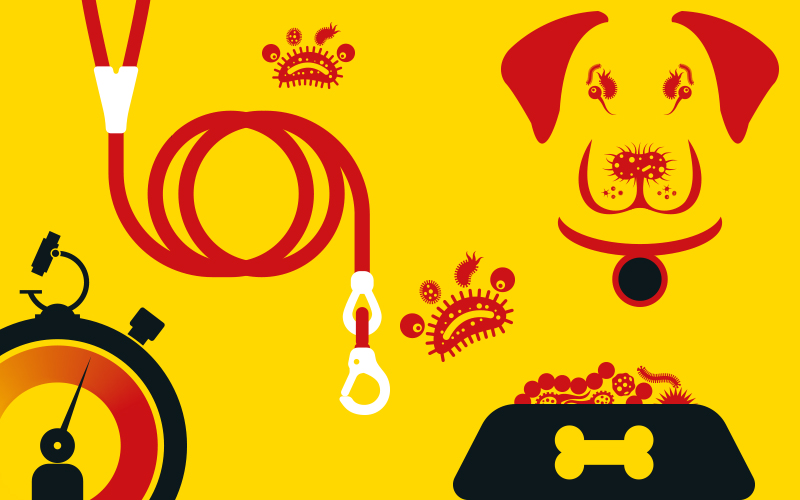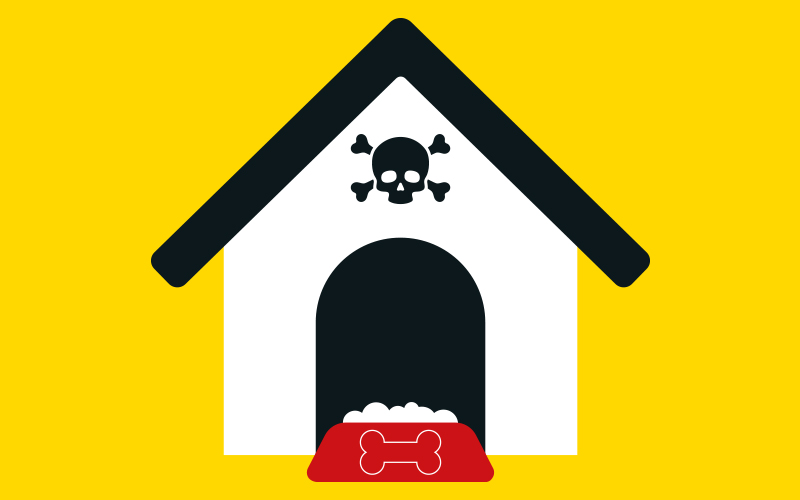Infections caused by antimicrobial-resistant organisms are increasing. From dog food to climate change, we look at the issues.

By now we’re familiar with the projected statistic that resistance to antibiotics will cause 10 million deaths worldwide each year by 2050, if no action is taken. Research and diagnostic methods are emerging all the time to tackle global antimicrobial resistance (AMR), classified by the World Health Organization as one of the greatest public health threats.
According to some of the latest research in the field, the trend for feeding dogs raw food could fuel the spread of antibiotic-resistant bacteria in humans. Researchers at the University of Porto in Portugal found the bacteria enterococci – that can cause severe infection if spread from the intestines to other parts of the body – in raw dog food.

They analysed 55 samples of dog food (including wet, dry and raw-frozen) from supermarkets and pet shops, and found that 30 (54%) contained enterococci. Some of the bacteria were genetically identical to bacteria isolated from hospital patients in the UK, Germany and the Netherlands. Multidrug-resistant bacteria were present in only three of the non-raw samples.
More than 40% of the bacterial samples were resistant to a range of antibiotics, including ampicillin and ciprofloxacin. There was also resistance to the “last-resort” antibiotic linezolid – used for severe infections when other drugs have failed – in 23% of the samples.
“The close contact of humans with dogs and the commercialisation of the studied brands in different countries poses an international public health risk,” says one of the lead researchers, Dr Ana R. Freitas, Post-doc Researcher in microbiology. “European authorities must raise awareness about the potential health risks when feeding raw diets to pets and the manufacture of dog food, must be reviewed.”
Rapid antimicrobial susceptibility testing
The University of Bristol has been working with Vitamica – a company that emerged from the university itself – to develop diagnostic technology that can show very quickly whether an antibiotic is suitable for particular bacteria.
Rapid antimicrobial susceptibility testing (AST) of patient samples can inform doctors which antibiotics will be effective for an individual patient’s infection within one hour, compared with the usual 48 hours it takes to get test results obtained from growing the bacteria. This type of AST is based on optical technology that uses lasers to detect tiny fluctuations within the individual bacteria, indicating in a few seconds whether the cells are alive or not.
“Having to grow the bacteria that cause the infection takes time, particularly for bloodstream infections where you need a test result really quickly,” says Professor Matthew Avison. “We have developed a rapid test where you can take a clinical sample, stick it in a machine that shines some lasers at the bacteria. If the bacteria are alive, they are ‘wiggling’, if you add an antibiotic that works they stop wiggling. In a few minutes you can get a sense of whether or not bacteria are susceptible to antibiotics.”
Researchers at the University of Bristol also found that feeding raw meat to puppies was a big risk factor in those puppies carrying antibiotic-resistant bacteria. In their study of the transmission of antibiotic-resistant bacteria between animals and humans, they compared clinical samples from people with urinary tract infections and puppies’ faecal samples, finding antibiotic-resistant bacteria that are almost identical.
“The resistant organisms that are in that dog food are actually sticking inside the dogs and they are excreting the bacteria in their faeces,” says Matthew Avison, Professor of Molecular Biology at the University of Bristol. “We’re concerned that what this shows is that raw feeding of your pet dog will put you and your family at more risk of being colonised by AMR bacteria.”
A slow-moving pandemic
AMR is the next major pandemic, according to Dr Tina Joshi, Lecturer in Molecular Biology at the University of Plymouth. “There are a lot of parallels with AMR and COVID-19 in that we have a lot of antibiotics for AMR organisms, like antimicrobials for malaria, but there are organisms developing resistance at a phenomenal rate,” she says. “AMR microorganisms are very dangerous and there are thousands of them.”There’s also a “big Venn diagram” of where AMR and COVID-19 overlap, according to Avison. “Quite a number of people who die of COVID-19 will also get a secondary bacterial infection that is resistant to antibiotics. AMR is going to make COVID-19 worse, just as much as AMR makes any infection worse.”
“If we do nothing then it will at some point become a much bigger deal than COVID-19”
Almost every person in a country like the UK will be carrying antibiotic-resistant bacteria around with them now. “While the relative risk of those people getting an infection on a day-to-day basis is pretty low, almost all of us in our lives will get an infection from those bacteria, whether a wound infection or bacterial pneumonia or something more serious,” says Avison. “The older we are the more likely that is to happen and the more likely we will have had antibiotics, so the more likely we are to carry antibiotic-resistant bacteria. If we do nothing in terms of reducing the rate at which resistant infections rise, better diagnostics and new antimicrobials, then it will at some point become a much bigger deal than COVID-19.”
Positive developments
There is a “lot to write home about”, says Dr Joshi, not least the government’s 20-year vision and five-year action plan to contain and control AMR and the fact the issue was actually addressed at the G7 summit in June. “[Government Special Envoy on AMR] Professor Dame Sally Davies is spearheading the changes that need to be made at a policy level and there is a global consortium of scientists and industry actively trying to tackle AMR,” she says. “We have got to a point where funding is being directed to diagnostics innovation but in companies. Industry is starting to get involved.”
Dr Joshi is developing diagnostics at point of care that can provide a result on a sample within the time of a GP’s appointment, without too many steps for extraction and confirmation. She says a really important development is the NHS’ “subscription” style payment model to incentivise pharmaceutical companies to develop new drugs. “That’s fantastic because it is rationalising antibiotic use and enabling stewardship.”
Avison is involved with developing inhibitors of resistance, synthetic chemicals that are designed to get into bacteria and block AMR mechanisms. The inhibitor is administered at the same time as the antibiotic to block the resistance from the bacteria and allow the bacteria to continue to work.
“That’s where we’ve had most success in recent times, particularly against those Gram-negative bacteria,” he says. “They are changing the face of antibiotic chemotherapy, because they are effectively stripping out many of the problems we have with antibiotic resistance. They are more likely to be an ongoing way of combating resistance rather than the development of new antibiotics.”

- An estimated 1900 people around the world die each day of infections that are resistant to antibiotics
- In the UK, an estimated 12,000 people die each year from antibiotic resistance
- Estimated AMR infections diagnosed in England increased by 3216 in 2019, to 65,152
- E. coli remains the most common bloodstream infection – 77.5 cases per 100,000 of the population
- AMR bloodstream infections have risen by 32% since 2015
- AMR is linked to 1 in 5 people with a key bacterial bloodstream infection
- Antibiotic consumption continues to fall year-on-year. In 2019, total consumption fell to 17.9 defined daily doses per 1000 people per day, compared with 19.4 in 2015.
What needs to be done
This is especially important given the finite nature of antibiotics. “We always have to remember that antibiotics are natural products, they are produced by bacteria and fungi in the environment and they are literally dug out of the ground – they are not manmade,” Avison says.
Dr Joshi adds: “Climate change is a huge threat to our species and it’s enabling AMR and the spread of infectious diseases. The economic pipeline for antibiotic development is not viable – we have scientists and companies developing antibiotics that may be useful for last resort but, they’re all getting shelved. We need change at a policy level.”
She advocates governments and policymakers demonstrate clearly the links between climate change and AMR, and curriculum changes for medicine that allows for better delivery of knowledge about AMR for future doctors. “Hospitals have changed significantly because of COVID, they’ll change even more significantly because of AMR,”
she adds. “If we implement appropriate infection control in a hospital environment, and utilise appropriate disinfectants we can stop the spread of more or less any microorganism. That needs to be reviewed because it has a very immediate impact.”
Modern medical practices are underpinned by the use of antibiotics. As resistance increases and antibiotics dwindle, diagnostics and practices in medicine must change in order to reverse that projected future.
Image credit | iStock| Shutterstock




